
Friday, December 31, 2010
As The Years Fly By - 2011 Already
Thursday, December 30, 2010
Top 10 Mysterious World Landmarks
The world is filled with ancient monuments built by master craftsmen in order to honor everything from kings and presidents to religious figures. And although most of these landmarks have been carefully studied and researched by scientists and historians, some are simply so old, incomplete, or obscure that we still don’t know very much about why they were built or what purpose they served. The following are 10 world landmarks that, whether by intention or simply due to the passage of time, continue to baffle the people who study them.
10. The Cahokia Mounds
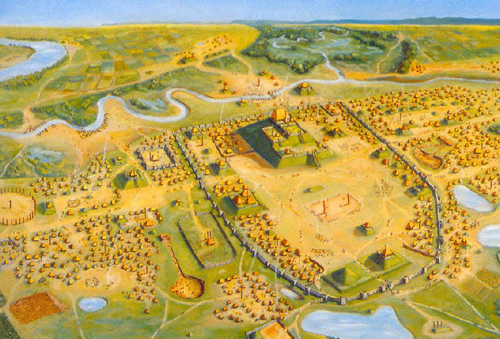
Cahokia is the name given to an Indian settlement that exists outside of Collinsville, Illinois. Archeologists estimate that the city was founded sometime around 650 AD, and its complex network of burial grounds and sophisticated landscaping prove that it was once a thriving community. It has been estimated that at its peak the city was home to as many as 40,000 people, which would have made it the most populous settlement in America prior to the arrival of the Europeans. The most notable aspect of Cahokia today are the 80 mounds of earth, some as high as 100 feet, which dot the 2,200-acre site. These helped create a network of plazas throughout the city, and it is believed that important buildings, like the home of the settlement’s chief, were built on top of them. The site also features a series of wooden posts that archeologists have dubbed “woodhenge.” The posts are said to mark the solstices and equinoxes, and supposedly figured prominently in the community’s astronomical mythology.
The Mystery
Although scientists are constantly discovering new information about the Cohokia community, the biggest mystery that remains is which modern Indian tribe is descended from the residents of the ancient city, as well as just what it was that caused them to abandon their settlement.
9. Newgrange
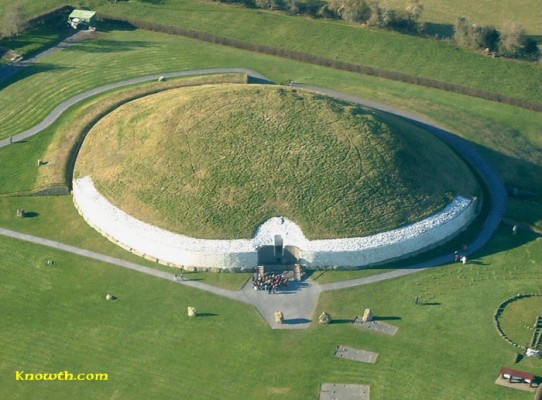
Considered to be the oldest and most famous prehistoric site in all of Ireland, Newgrange is a tomb that was built from earth, wood, clay, and stone around 3100 BC, some 1000 years before the construction of the pyramids in Egypt. It consists of a long passage that leads to a cross-shaped chamber that was apparently used as a tomb, as it contains stone basins filled with cremated remains. The most unique feature of Newgrange is its careful and sturdy design, which has helped the structure remain completely waterproof to this day. Most amazing of all, the entrance to the tomb was positioned relative to the sun in such a way that on the winter solstice, the shortest day of the year, the rays from the sun are channeled through the opening and down the nearly 60 foot passageway, where they illuminate the floor of the monument’s central room.
The Mystery
Archeologists know Newgrange was used as a tomb, but why and for who still remains a mystery. The painstaking design needed to guarantee that the yearly solstice event occurs suggests that the site was held in high regard, but other than the obvious hypothesis that the sun featured prominently in the mythology of the builders, scientists are at a loss to describe the true reason for Newgrange’s construction.
8. The Yonaguni Monument
Of all the famous monuments in Japan, perhaps none is more perplexing than Yonaguni, an underwater rock formation that lies off the coast of the Ryuku Islands. It was discovered in 1987 by a group of divers who were there to observe Hammerhead sharks, and it immediately sparked a huge amount of debate in the Japanese scientific community. The monument is made up of a series of striking rock formations including massive platforms, carved steps, and huge stone pillars that lie at depths of 5-40 meters. There is a triangular formation that has become known as “the turtle” for its unique shape, as well as a long, straight wall that borders one of the larger platforms. The currents in the area are known for being particularly treacherous, but this has not stopped the Yonaguni monument from becoming one of the most popular diving locations in all of Japan.
The Mystery
The ongoing debate surrounding Yonaguni centers on one key subject: is the monument a natural phenomenon, or is it man-made? Scientists have long argued that millennia of strong currents and erosion have carved the formations out of the ocean floor, and they point to the fact that the monument is all one piece of solid rock as proof that it was not assembled by a builder. Others, though, point to the many straight edges, square corners and 90-degree angles of the formation as proof that it’s artificial. They often cite one formation in particular, a section of rock that resembles a crude carving of a human face, as evidence. If they are right, then an even more interesting mystery presents itself: who constructed the Yonaguni Monument, and for what purpose?
7. The Nazca Lines
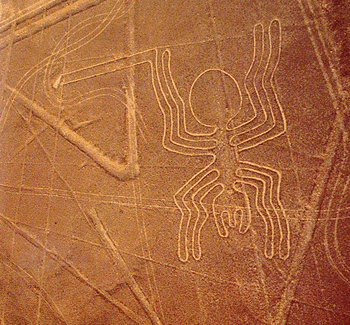
The Nazca lines are a series of designs and pictographs carved into the ground in the Nazca Desert, a dry plateau located in Peru. They cover an area of some 50 miles, and were supposedly created between 200 BC and 700 AD by the Nazca Indians, who designed them by scraping away the copper colored rocks of the desert floor to expose the lighter-colored earth beneath. The lines have managed to remain intact for hundreds of years thanks to the region’s arid climate, which sees it receive little rain or wind throughout the year. Some of the lines span distances of 600 feet, and they depict everything from simple designs and shapes to characterizations of plants, insects, and animals.
The Mystery
Scientists know who made the Nazca Lines and how they did it, but they still don’t know why. The most popular and reasonable hypothesis is that the lines must have figured in the Nazca people’s religious beliefs, and that they made the designs as offerings to the gods, who would’ve been able to see them from the heavens. Still, other scientists argue that the lines are evidence of massive looms that the Nazcas used to make textiles, and one investigator has even made the preposterous claim that they are the remnants of ancient airfields used by a vanished, technologically advanced society.
6. Goseck Circle
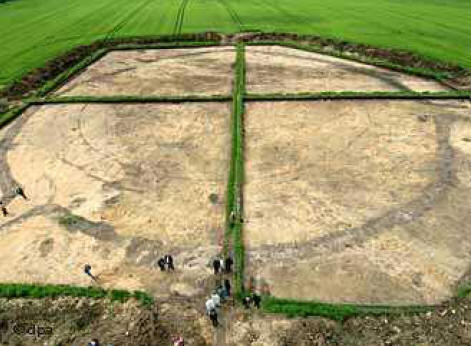
One of the most mysterious landmarks in Germany is the Goseck Circle, a monument made out of earth, gravel, and wooden palisades that is regarded as the earliest example of a primitive “solar observatory.” The circle consists of a series of circular ditches surrounded by palisade walls (which have since been reconstructed) that house a raised mound of dirt in the center. The palisades have three openings, or gates, that point southeast, southwest, and north. It is believed that the monument was built around 4900 BC by Neolithic peoples, and that the three openings correspond to the direction from which the sun rises on the winter solstice.
The Mystery
The monument’s careful construction has led many scientists to believe that the Goseck Circle was built to serve as some kind of primitive solar or lunar calendar, but its exact use is still a source of debate. Evidence has shown that a so-called “solar cult” was widespread in ancient Europe. This has led to speculation that the Circle was used in some kind of ritual, perhaps even in conjunction with human sacrifice. This hypothesis has yet to be proven, but archeologists have uncovered several human bones, including a headless skeleton, just outside the palisade walls.
5. Sacsayhuaman
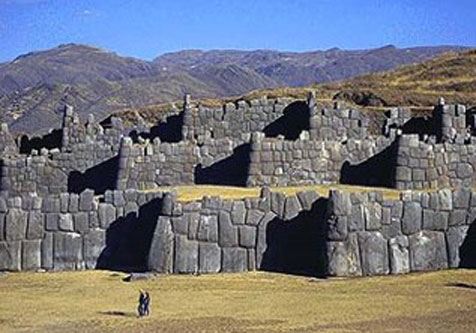
Not far from the famous Inca city of Machu Picchu lies Sacsayhuaman, a strange embankment of stone walls located just outside of Cuzco. The series of three walls was assembled from massive 200-ton blocks of rock and limestone, and they are arranged in a zigzag pattern along the hillside. The longest is roughly 1000 feet in length and each stands some fifteen feet tall. The monument is in astonishingly good condition for its age, especially considering the region’s propensity for earthquakes, but the tops of the walls are somewhat demolished, as the monument was plundered by the Spanish to build churches in Cuzco. The area surrounding the monument has been found to be the source of several underground catacombs called chincanas, which were supposedly used as connecting passageways to other Inca structures in the area.
The Mystery
4. The Easter Island Moai
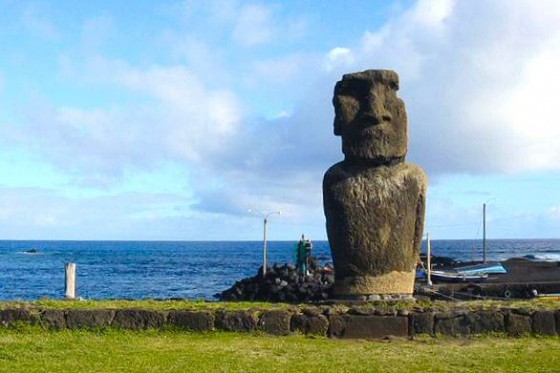
One of the most iconic series of monuments in the Pacific islands is the Moai, a group of huge statues of exaggerated human figures that are found only on the small, isolated island of Rapa Nui, or Easter Island. The Moai were carved sometime between 1250 and 1500 AD by the island’s earliest inhabitants, and are believed to depict the people’s ancestors, who in their culture were held in the same regard as deities. The Moai were chiseled and carved from tuff, a volcanic rock that is prevalent on the island, and they all feature the same characteristics of an oversized head, broad nose, and a mysterious, indecipherable facial expression. Scientists have determined that as many as 887 of the statues were originally carved, but years of infighting among the island’s clans led to many being destroyed. Today, only 394 are still standing, the largest of which is 30 feet tall and weighs over 70 tons.
The Mystery
3. The Georgia Guidestones
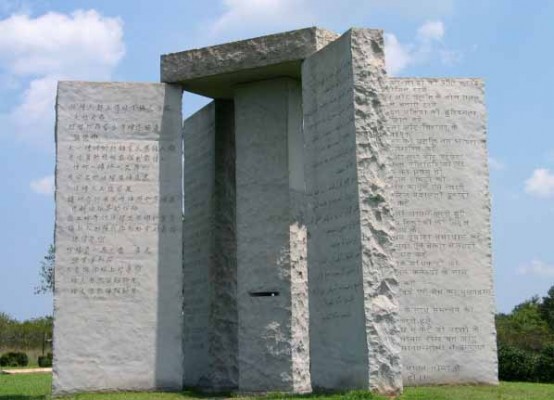
While most of the mysterious monuments on this list only became that way as centuries passed, the Georgia Guidestones, also known as American Stonehenge, are one landmark that was always intended to be an enigma. The monument, which consists of four monolithic slabs of granite that support a single capstone, was commissioned in 1979 by a man who went by the pseudonym of R.C. Christian. A local mason carefully crafted it so that one slot in the stones is aligned with the sun on the solstices and equinoxes, and one small hole is always pointed in the direction of the North Star. Most interesting, though, are the inscriptions on the slabs, which an accompanying plaque describes as “the guidestones to an Age of Reason.” In eight different languages, the slabs offer a strange ten-point plan to ensure peace on Earth that includes vague proclamations like “prize truth–beauty–love–seeking harmony with the infinite,” to very specific commands like “maintain humanity under 500,000,000 in perpetual balance with nature.” Comments like this one have made the Guidestones one of the most controversial landmarks in the United States, and they have long been protested and even vandalized by groups that would like to see them demolished.
The Mystery
2. The Great Sphinx of Giza
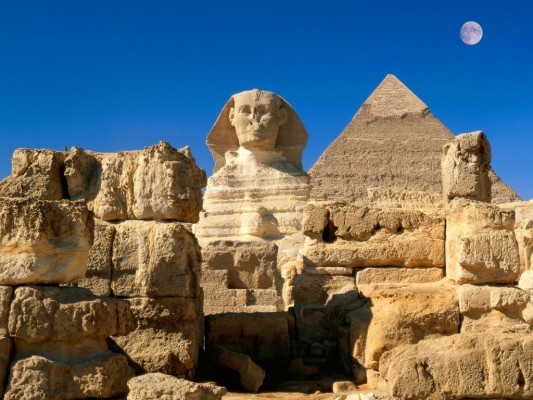
Sphinxes are massive stone statues that depict the body of a reclining lion with the head and face of a human. The figures are found all over the world in different forms, but they are most commonly linked with Egypt, which features the most famous example in the form of the Great Sphinx of Giza. Incredibly, the statue is carved out of one monolithic piece of rock, and at 240 feet long, 20 feet wide, and 66 feet tall, it is considered to be the biggest monument of its kind in the world. Historians largely accept the function of the Sphinx to have been that of a symbolic guardian, since the statues were strategically placed around important structures like temples, tombs, and pyramids. The Great Sphinx of Giza appears to be no different. It stands adjacent to the pyramid of the pharaoh Khafra, and most archeologists believe that it is his face that is depicted on that of the statue.
The Mystery
Despite its reputation as one of the most famous monuments of antiquity, there is still very little known about the Great Sphinx of Giza. Egyptologists might have a small understanding of why the statue was built, but when, how, and by who is still shrouded in mystery. The pharaoh Khafra is the main suspect, which would date the structure back to around 2500 BC, but other scientists have argued that evidence of water erosion of the statue suggests that it is much older and perhaps even predated the dynastic era of the Egyptians. This theory has few modern adherents, but if true it would mean the Great Sphinx of Giza is even more mysterious than previously believed.
1. Stonehenge

Of all the world’s famous monuments, none has gained as much of a reputation for pure, simple mystery as Stonehenge. Stonehenge has been inspiring debate among scholars, scientists, and historians since the Middle Ages. Located in the English countryside, the landmark is believed to date back to 2500 BC, and consists of several mammoth pieces of rock arranged and piled on top of one another in what appears at first to be a random design. The site is surrounded by a small, circular ditch, and is flanked by burial mounds on all sides. Although the rock formations that still remain are undoubtedly impressive, it is thought that the modern version of Stonehenge is only a small remnant of a much larger monument that was damaged with the passing of time, and it is largely believed that the building process was so extensive that it could have lasted on and off for anywhere from 1500 to 7000 years.
The Mystery
Wednesday, December 29, 2010
Winter Reading
Tuesday, December 28, 2010
In New York Snow is For The Little People
It has years since I have gone that long with out an internet fix in years, and while I thought that I would end up like an addict yearning for crack, I did just fine. I spent a lovely day with my family on Christmas Eve and then cooked a traditional Christmas meal at home on Christmas day. Boxing day was spent relaxing at home with a book or two and then yesterday it was back to the office and business as usual.
Happily, the deluge stopped, the sky cleared and the sun has once again brightened Southern California.
And after seeing so many pretty pictures of New York and New England blanketed in snow, I'm glad that I am not there to share in the experience. I remember snow storms when I was growing up in Brookline Massachusetts, but I don't remember them leading to an utter breakdown in transportation systems and people being stranded at airports for days.
But that was Boston, so what's up with New York?
Send in the Plows! Outrage as Transit a Mess, NYers Still Stuck
New Yorkers are grumbling about the city's and MTA's preparedness
Two days after slamming the tri-state, millions of people affected by a post-Christmas blizzard continue to dig out from a storm that shut down area airports, crippled commuter train and subway service and stranded thousands traveling during the holiday weekend.
The sixth largest snowstorm in the history of New York City dumped two feet of snow and left many, especially those living in the outer boroughs and small suburban side streets, feeling trapped or ignored as city resources went to dig out Manhattan.
"I'm furious at Mayor Bloomberg, he's a rich man, so he doesn't care about the little people," said New Enrico's Car Service livery driver Julio Carpio, speaking in Spanish. "I have to work, why aren't people out there plowing? Why does the mayor always go on TV the night before to say, 'We're all set with a fleet of salt trucks,'? and then you never see a single truck. They always abandon Queens."
You would think that New York could handle 20 inches of snow without issues, but apparently not. God knows that any hick town in Colorado or Idaho could handle 20 inches.
Some New Yorkers in the outer boroughs are complaining that the city took too long to plow their neighborhoods, ignoring them in favor of wealthier Manhattan areas. City officials said that some side streets might not be cleared until well into Tuesday.
State Senator Carl Kruger blasted the city's response, saying part of Mill Basin and Manhattan Beach were not plowed even once by Monday evening.
"It is unconcsconsiable," Kruger told NBC New York. "It has to be addressed. There has to be some reason given....When the Fire Department asks to declare a state of emergency and the OEM denies that request, then there is something wrong."
So the upper East Side gets plowed but the people in the boroughs have to put up with snow...
While I love to see the photos winter wonderlands from the snow covered fields in Wales to the ice laden trees in Germany, I am very happy that I live in Los Angeles and not in New York.
Monday, December 27, 2010
Hot Jennifer Aniston, Jennifer Aniston Pictures, Wallpapers, Pics, Photo Gallery
11 February 1969, Sherman Oaks, California, USA
Nickname
Jen
Jenny
Height
5' 6" (1.68 m)
Jennife Aniston is very hot and sexy actress in hollywood. She is very populer giel in whole world.Jennifer Aniston spent a year of her childhood living in Greece with her family. Her family then relocated to New York City where her parents, John Aniston and Nancy Dow, divorced when she was 9. Jennifer was raised by her mother and her father landed a role, as "Victor Kiriakis", on the daytime soap "Days of Our Lives" (1965). Jennifer had her first taste of acting at age 11 when she joined the Rudolf Steiner School's drama club. It was also at the Rudolf Steiner School that she developed her passion for art. She began her professional trainingas a drama student at New York's School of Performing Arts, aka the "Fame" school. It was a division of Fiorello H. LaGuardia High School of Music and the Arts. In 1987, after graduation, she appeared in such Off-Broadway productions as "For Dear Life" and "Dancing on Checker's Grave". In 1989, she landed her first television role, as a series regular on "Molloy" (1990).










Hot Jennifer Aniston, Jennifer Aniston Pictures, Wallpapers, Pics, Photo Gallery
11 February 1969, Sherman Oaks, California, USA
Nickname
Jen
Jenny
Height
5' 6" (1.68 m)
Jennife Aniston is very hot and sexy actress in hollywood. She is very populer giel in whole world.Jennifer Aniston spent a year of her childhood living in Greece with her family. Her family then relocated to New York City where her parents, John Aniston and Nancy Dow, divorced when she was 9. Jennifer was raised by her mother and her father landed a role, as "Victor Kiriakis", on the daytime soap "Days of Our Lives" (1965). Jennifer had her first taste of acting at age 11 when she joined the Rudolf Steiner School's drama club. It was also at the Rudolf Steiner School that she developed her passion for art. She began her professional trainingas a drama student at New York's School of Performing Arts, aka the "Fame" school. It was a division of Fiorello H. LaGuardia High School of Music and the Arts. In 1987, after graduation, she appeared in such Off-Broadway productions as "For Dear Life" and "Dancing on Checker's Grave". In 1989, she landed her first television role, as a series regular on "Molloy" (1990).










Hot Jennifer Aniston, Jennifer Aniston Pictures, Wallpapers, Pics, Photo Gallery
11 February 1969, Sherman Oaks, California, USA
Nickname
Jen
Jenny
Height
5' 6" (1.68 m)
Jennife Aniston is very hot and sexy actress in hollywood. She is very populer giel in whole world.Jennifer Aniston spent a year of her childhood living in Greece with her family. Her family then relocated to New York City where her parents, John Aniston and Nancy Dow, divorced when she was 9. Jennifer was raised by her mother and her father landed a role, as "Victor Kiriakis", on the daytime soap "Days of Our Lives" (1965). Jennifer had her first taste of acting at age 11 when she joined the Rudolf Steiner School's drama club. It was also at the Rudolf Steiner School that she developed her passion for art. She began her professional trainingas a drama student at New York's School of Performing Arts, aka the "Fame" school. It was a division of Fiorello H. LaGuardia High School of Music and the Arts. In 1987, after graduation, she appeared in such Off-Broadway productions as "For Dear Life" and "Dancing on Checker's Grave". In 1989, she landed her first television role, as a series regular on "Molloy" (1990).










Top Ten Animals in Space
How many other animals have been put into space and why? Looking into the subject, it’s quite entertaining. so here’s my top ten list of animals sent into space:
10. Flies
In 1942 the first animals were put into space. they were ironically flies. Fruit flies and corn seeds took a one way trip on a US V2 rocket, (you know the ones they built using Nazi technology and slaves).
9. Dogs
On November 3rd, 1957 the first animal in orbit was Laika, the Russian space dog. She flew aboard Sputnik 2 and died during the flight. The Soviets flew 10 more dogs on that programme until April 12, 1961 when Yuri Gagarin became the first man in orbit.
Belka and Strelka (seriously, who named these dogs?) were the first mammals to be successfully returned to the Earth after orbital flight in 1960. you can them in the picture. The other canine record holders are Veterok and Ugolyok, two dogs that spent 22 days in space before returning unharmed in 1966.
8. Fish
Several fish have visited space. specifically the species Mummichog, Japanese Killfish and Zebra Danio. The Killfish were in fact the only survivors of the Columbia distaster.
7. Spiders
Experimenting with low gravity environments is obviously a big reason behind putting animals in space. So can a spider build a web in orbit? The answer is yes. Anita and Arabella were two garden spiders that flew on SkyLab in 1973.
The webs were seen to be finer that on Earth and to have variations in thickness throughout each web, unlike the highly uniform webs spun on Earth. Anit’s remains are still kept in a jar at the Smithsonian for all to see. You can see her web above.
6. Cats
Two cats have graced the skies, both put there by the French. The first was Felix in 1963, who survived his trip despite having electrodes implanted into his brain. The second cat’s name does not seem to be obvious, but he did not survive. I can has spacesuit?
5. Newts
In 1985, the Russians sent 10 newts into space after amputating their forearms. They were trying to study the regeneration of cells in low-gravity.
4. Mice and Rats
Many mice have been into space. The US reportedly put loads of them up there in the 1950s, but only the first one survived. In the 1960s, China, the USA and Russia all put many mice into space and into orbit. Nothing much seems to have come of this so far as popular culture is concerned. Douglas Adams, may have had other things to say about that though.
Russia flew rats and mice, as well as hordes of other animals, during its Bion programs in the 60s and 70s. Bion spacecraft (shown above) were designed to test organisms in space. As you can see they look very comfortable. If only NASA had made them, they would have at least had cupholders.
3. Frogs
My favourite space dwellers are the Orbiting Frogs that were sent up in 1970. Why? Well of course it was to sudy motion sickness in space. Don’t you know that frogs get carsick?
The Orbiting Frog Otolith housed the bullfrogs for a week as they circled the Earth. Scientists measured their vital signs and once the experiment was over the simply left the frogs to work it out for themselves. Needless to say it pleases and disturbs me greatly that there are possibly still two frogs up there somewhere.
2. Tortoises
The tortoise is held in my esteem on this blog entry because it is the unlikely holder of not one, but two space records! In 1968 a Russian Tortoise became the first animal to go into deep space when it orbited the Moon and returned safely to the Earth.
1. Monkeys
Of course I had to end with monkeys. On June 11th, 1948 a monkey named Albert was the first to be put into space by NASA the Americans. He was under anesthetic during the launch and never returned. Many other monkeys have famously been put into space.
In 1959, Able and Baker, a rhesus and squirrel monkey respectively, were the first to survive spaceflight. It sounds like the premise of a Warner Brothers’ cartoon. They were placed in the nosecone of a missile and shot nearly 400 hundred miles above the surface of the Earth and over a distance of 1,700 miles. They travelled at 100,000 mph for 16 minutes. Needless to say they experience G-forces above and beyond anything normal (Wikipedia says 16g).
Able died a few days later from complications related to one of his implanted electrodes, but Baker lived until 1984 in the NASA Spaceflight centre in Huntsville, Alabama, possibly running the place.










